This is a story of exploration and discovery. It’s about how our brewers think about hops and how that’s evolved over the years. It’s about technique and equipment and how we brew with hops. And it’s about how the other ingredients in beer can be used to adjust and amplify hop profiles.
And it goes way back, beyond the beginnings of the brewery to a time when founding brothers Chris and John Trogner were just starting to dig in to craft beer.
In the mid-’90s Chris was out at the University of Colorado in Boulder digging into the burgeoning craft scene, and he says to John, who’s back in Pennsylvania, “Hey, you gotta get out here and see this.”
John makes the move to Boulder and gets a job pushing a mop at a brewery. John being John, he starts digging in. He’s volunteering for anything he can at the brewery, getting to know the equipment, getting to know ingredients, and starting to wonder about the ‘why’ behind everything that brewers do.
 Chris had been going deep on the WHY as well. In fact, he’d started homebrweing in his backyard, and John joined him in that.
Chris had been going deep on the WHY as well. In fact, he’d started homebrweing in his backyard, and John joined him in that.
One of the beers they brewed was a California Common. It’s a style that has medium hop flavor, a little woody and rustic. Medium bitterness.
The California Common is not a popular style today, and it’s certainly not in the conversation of hoppy beers, but believe it or not, that’s really the genesis for the path that brings us all the way to beers like Perpetual IPA, Hop Knife Harvest IPA and Golden Thing.
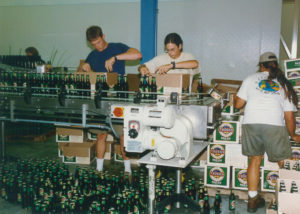 Fast-forward a few years, the brothers are back in their native central PA getting Tröegs off the ground. One of the very first beers they brew is Tröegs ESB, a classic English bitter.
Fast-forward a few years, the brothers are back in their native central PA getting Tröegs off the ground. One of the very first beers they brew is Tröegs ESB, a classic English bitter.
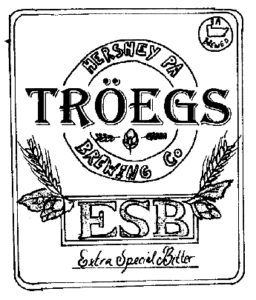 It has a malt backbone and – not unlike the California Common – an earthy hop profile. With Northern Brewer and Cascade hops in there, you start to get a little bit of citrus, but at this point, hops are still used primarily as a bittering component to balance out malt sweetness.
It has a malt backbone and – not unlike the California Common – an earthy hop profile. With Northern Brewer and Cascade hops in there, you start to get a little bit of citrus, but at this point, hops are still used primarily as a bittering component to balance out malt sweetness.
The ESB rolls into a game-changing beer for Troegs: HopBack Amber Ale. HopBack pulls in two new hops: Cascade and Nugget – and it also pulls in a new technique – using a Hopback to run hot wort through whole-leaf hops. So instead of hops being used solely for bittering, HopBack starts pulling in some citrusy and fruity aromatics.
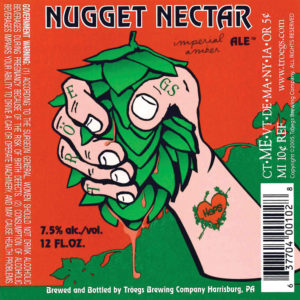 Then along comes Nugget Nectar. That’s where we start to turn up the volume on hops. Simcoe in particular brings in big notes of creamsicle, mango and grapefruit rind. And if you know the story of Tröegs, you know that Nugget Nectar was one of the beers that put us on the craft beer map.
Then along comes Nugget Nectar. That’s where we start to turn up the volume on hops. Simcoe in particular brings in big notes of creamsicle, mango and grapefruit rind. And if you know the story of Tröegs, you know that Nugget Nectar was one of the beers that put us on the craft beer map.
Up to this point, the exploration was mostly about varieties of hops and a little technique. And you can see that when we started pulling in hops like Cascade, Simcoe and Nugget, the profile moved from earthy, woody and spicy to citrusy, floral and dank. But in all of these beers – the ESB, HopBack and Nugget – the hops were still balanced with a robust malt backbone.
 Then came the move to Hershey. The big increase in capacity adds another poignant pitstop in the exploration: Perpetual IPA.
Then came the move to Hershey. The big increase in capacity adds another poignant pitstop in the exploration: Perpetual IPA.
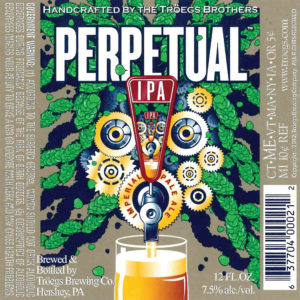 In Perpetual, that malty body starts to fall away. So we push that caramel side away and bring in hop flavor as the balancing component. It’s way less about bitterness and balance and more about the profile of the hops themselves. This is when hop selection becomes really important.
In Perpetual, that malty body starts to fall away. So we push that caramel side away and bring in hop flavor as the balancing component. It’s way less about bitterness and balance and more about the profile of the hops themselves. This is when hop selection becomes really important.
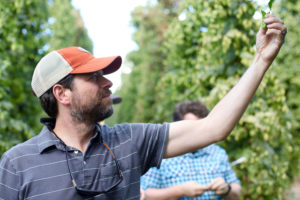 So the brewers start making the annual pilgrimage to Yakima to walk the fields and have this very hands-on relationship with hops. We no longer have that dominant malt profile, so the hops have to be just right, or Perpetual isn’t Perpetual. A couple of things held us back from brewing an IPA: capacity and a little bit of stubbornness. But once we did, we fell in love. Perpetual quickly became our top-selling beer, and it really started to open our eyes to the possibilities of hops.
So the brewers start making the annual pilgrimage to Yakima to walk the fields and have this very hands-on relationship with hops. We no longer have that dominant malt profile, so the hops have to be just right, or Perpetual isn’t Perpetual. A couple of things held us back from brewing an IPA: capacity and a little bit of stubbornness. But once we did, we fell in love. Perpetual quickly became our top-selling beer, and it really started to open our eyes to the possibilities of hops.
So as our brewers are out there exploring the fields and building relationship with hops, they start thinking more about how to get the profiles they’re experiencing into beers. So not only hop varieties, but hopping techniques and yeast and yeast management factor into the equation in big ways. Dry-hopping to pull in aroma becomes really important.
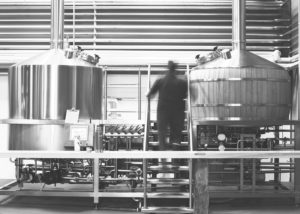 And this is also when our small-batch, experimental Scratch Series really comes into its own. Before this, Scratch was mostly about bringing back old recipes. But now, with all these new tools in the toolbox – ingredients, techniques, hop combinations – the Scratch Series allows us to explore and to learn and to ‘show our work’ along the way.
And this is also when our small-batch, experimental Scratch Series really comes into its own. Before this, Scratch was mostly about bringing back old recipes. But now, with all these new tools in the toolbox – ingredients, techniques, hop combinations – the Scratch Series allows us to explore and to learn and to ‘show our work’ along the way.
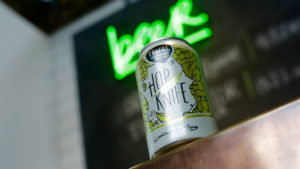 And the explorations take us in all sorts of directions. Hop Knife Harvest IPA being one of them. If Perpetual is based on the piney and dank side of hops, Hop Knife lightens up the malt even more and dives into the tropical side with El Dorado. And Hop Knife is the first really heavily dry-hopped beer we did and pushes hops deep into flavor and aroma and almost completely out of the bittering side. It was a big shift in our collective palate.
And the explorations take us in all sorts of directions. Hop Knife Harvest IPA being one of them. If Perpetual is based on the piney and dank side of hops, Hop Knife lightens up the malt even more and dives into the tropical side with El Dorado. And Hop Knife is the first really heavily dry-hopped beer we did and pushes hops deep into flavor and aroma and almost completely out of the bittering side. It was a big shift in our collective palate.
Along comes Blizzard of Hops, and that pushed even further into more hop aroma and less hop bitterness. Think spruce tips, pineapple and orange rind. (Not to mention a little haze before haze was cool.)
Then comes Nimble Giant. That’s when we started playing with the timing and temperature of hop additions. Cooling the wort before those hot-side additions allowed us to capture those notes of tropical fruit, pine sap and honeysuckle and leave the bitterness behind.
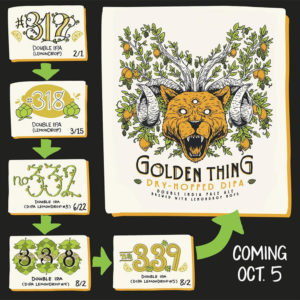 The same hopping technique was used on Golden Thing Dry-Hopped Double IPA. That was born from our exploration in the hop fields out in Yakima. Big, citrusy lemondrop hops grabbed our attention. So now we can have this really citrusy double IPA with no fruit additions. Just the right combination of Lemondrop, Denali and Centennial. And we found that combo through a series of Scratch beers.
The same hopping technique was used on Golden Thing Dry-Hopped Double IPA. That was born from our exploration in the hop fields out in Yakima. Big, citrusy lemondrop hops grabbed our attention. So now we can have this really citrusy double IPA with no fruit additions. Just the right combination of Lemondrop, Denali and Centennial. And we found that combo through a series of Scratch beers.
That’s what Scratch Series is all about. Each Scratch number – we’re closing in on 400! – represents something we want to better understand. To get to that WHY. And we’re not afraid to show our work along the way. We’re making incremental changes — 5, 6 or 7 swings at a beer – until we land on the final recipe. Until we land on Hop Knife, until we land on LolliHop or Golden Thing. Scratch is the way we develop all of our beers now.
So you can see from this path – from the California Common to Golden Thing – this years-long exploration, that we’ve taken hops in a bunch of different ways. And we’ve done it through different hop varieties, through selecting the right hops for our beers, through different hop combinations, through the techniques that we use, and through the relationship of hops to the other ingredients in beer. It’s been a long journey.
As John likes to say, “We do things a little slower. We sink deep roots. We really try to understand the why. There’s no rush to dive in without understanding each of the components.”
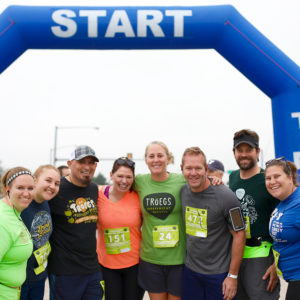 This fall, tune in to our Perpetual Exploration through Perpetual IPA, Hop Knife Harvest IPA, Golden Thing and a brand new hazy pale ale coming your way in early October. And don’t miss the chance to celebrate all things hoppy with us at the third-annual Harvest Hopfest weekend Oct. 4-6! We’ll have exclusive hop-centric beers, the return of the HopDash, a whole bunch of live music in the Beer Garden … and more! Stay tuned.
This fall, tune in to our Perpetual Exploration through Perpetual IPA, Hop Knife Harvest IPA, Golden Thing and a brand new hazy pale ale coming your way in early October. And don’t miss the chance to celebrate all things hoppy with us at the third-annual Harvest Hopfest weekend Oct. 4-6! We’ll have exclusive hop-centric beers, the return of the HopDash, a whole bunch of live music in the Beer Garden … and more! Stay tuned.
